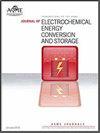Macroscopic architecture design of lithium metal electrodes: impacts of millimeter-size hollows on economization, cyclability and utilization
IF 1.9
4区 工程技术
Q3 ELECTROCHEMISTRY
Journal of Electrochemical Energy Conversion and Storage
Pub Date : 2022-08-11
DOI:10.1115/1.4055195
引用次数: 1
Abstract
A macroscopic architecture design of lithium metal electrodes for solving the problem of extremely excessive lithium metal is proposed in this paper. By employing a simple mechanical processing method, macroscopic hollows within lithium foils are introduced, and consequently the amount of lithium metal is economized significantly. Cyclability of lithium foils with millimeter-size hollows is evaluated jointly via modeling and experiments. The results suggest that the well-designed macroscopic hollow causes controllable sacrifices of battery cycling performances and considerably boosts the utilization of lithium metal. The relationship of economization, cyclability and utilization of lithium metal is also discussed. The universality of the results is also verified in different battery systems. Meanwhile, the initial hollows are found to heal morphologically after a series of electrochemical cycles, and the existence of lithium metal in the healing product is also confirmed, indicating that hollows provide room for the in-plane lithium dendrite growth. Based on these findings, this work provides a new perspective on the architecture design of lithium metal electrodes.锂金属电极宏观结构设计:毫米尺寸的空心对经济性、可循环性和利用率的影响
为解决金属锂极过量的问题,提出了一种金属锂电极的宏观结构设计。采用简单的机械加工方法,在锂箔中引入宏观空洞,从而显著节约锂金属的用量。通过模型分析和实验分析,对具有毫米级空腔的锂箔的可循环性进行了评价。结果表明,设计良好的宏观空心对电池循环性能的牺牲是可控的,大大提高了锂金属的利用率。讨论了金属锂的经济性、可循环性与资源化利用的关系。结果的通用性也在不同的电池系统中得到验证。同时,经过一系列电化学循环,发现初始空洞在形态上愈合,并且在愈合产物中也存在金属锂,表明空洞为平面内锂枝晶生长提供了空间。基于这些发现,本工作为锂金属电极的结构设计提供了一个新的视角。
本文章由计算机程序翻译,如有差异,请以英文原文为准。
求助全文
约1分钟内获得全文
求助全文
来源期刊

Journal of Electrochemical Energy Conversion and Storage
Engineering-Mechanics of Materials
CiteScore
4.90
自引率
4.00%
发文量
69
期刊介绍:
The Journal of Electrochemical Energy Conversion and Storage focuses on processes, components, devices and systems that store and convert electrical and chemical energy. This journal publishes peer-reviewed archival scholarly articles, research papers, technical briefs, review articles, perspective articles, and special volumes. Specific areas of interest include electrochemical engineering, electrocatalysis, novel materials, analysis and design of components, devices, and systems, balance of plant, novel numerical and analytical simulations, advanced materials characterization, innovative material synthesis and manufacturing methods, thermal management, reliability, durability, and damage tolerance.
 求助内容:
求助内容: 应助结果提醒方式:
应助结果提醒方式:


